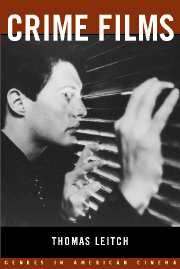Book contents
- Frontmatter
- Contents
- List of Illustrations
- Acknowledgments
- 1 The Problem of the Crime Film
- 2 Historical and Cultural Overview
- 3 Critical Overview
- 4 Fury and the Victim Film
- 5 The Godfather and the Gangster Film
- 6 Double Indemnity and the Film Noir
- 7 Basic Instinct and the Erotic Thriller
- 8 Murder on the Orient Express, Blue Velvet, and the Unofficial-Detective Film
- 9 Chinatown and the Private-Eye Film
- 10 Bullitt and the Police Film
- 11 Reversal of Fortune and the Lawyer Film
- 12 Fargo and the Crime Comedy
- 13 Conclusion: What Good Are Crime Films?
- Notes
- Selected Bibliography
- Filmography/Videography
- Index
4 - Fury and the Victim Film
Published online by Cambridge University Press: 27 October 2009
- Frontmatter
- Contents
- List of Illustrations
- Acknowledgments
- 1 The Problem of the Crime Film
- 2 Historical and Cultural Overview
- 3 Critical Overview
- 4 Fury and the Victim Film
- 5 The Godfather and the Gangster Film
- 6 Double Indemnity and the Film Noir
- 7 Basic Instinct and the Erotic Thriller
- 8 Murder on the Orient Express, Blue Velvet, and the Unofficial-Detective Film
- 9 Chinatown and the Private-Eye Film
- 10 Bullitt and the Police Film
- 11 Reversal of Fortune and the Lawyer Film
- 12 Fargo and the Crime Comedy
- 13 Conclusion: What Good Are Crime Films?
- Notes
- Selected Bibliography
- Filmography/Videography
- Index
Summary
In Vittorio De Sica's great Italian neorealist movie The Bicycle Thief (Ladri di biciclette, 1948), Antonio Ricci (Lamberto Maggiorani) is a deliveryman whose bicycle, on which his new job depends, is stolen. With his little boy, Bruno (Enzo Staiola), in tow, Ricci scours Rome in search of the stolen bicycle, asking questions of dozens of people, but he fails to recover it and is nearly arrested himself when he tries to steal another bicycle he is mistakenly convinced is his. The film ends with father and son walking forlornly down the street away from the camera, accepting the fact that they will never see the bicycle again.
Legend has it that De Sica and his screenwriter, Cesare Zavattini, briefly shopped the idea of the film to Hollywood, only to be told that no studio would be interested unless Cary Grant were cast in the lead role. Whether or not it is true, this anecdote illustrates a fundamental contrast between European cinema and Hollywood genre films. If every crime story depends on a victim, a criminal, and an avenger, the victim is the structuring absence in American crime movies. The role of the victim of crime is so perennially unfashionable in Hollywood that it is hard to think of a single victim-hero, for example, in the years between 1919, when D. W. Griffith's Broken Blossoms shows Lucy Burrows (Lillian Gish) destroyed by her abusive boxer father (Donald Crisp), and 1944, when Gregory Anton (Charles Boyer) tries to drive his bride Paula Alquist (Ingrid Bergman) insane in Gaslight so that he can ransack her house for the jewels he failed to find when he murdered her aunt.
- Type
- Chapter
- Information
- Crime Films , pp. 79 - 102Publisher: Cambridge University PressPrint publication year: 2002



